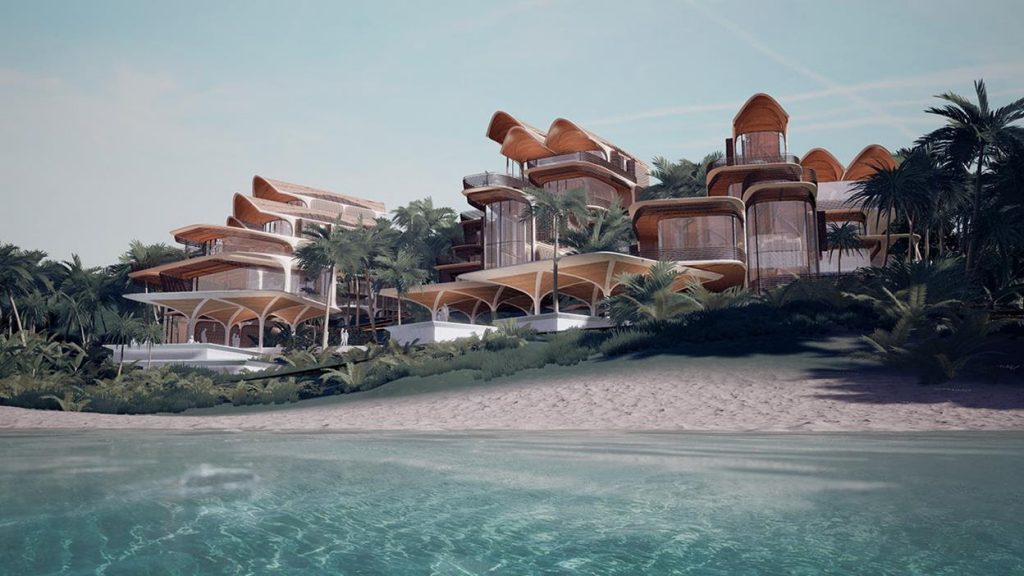| Zaha
Hadid Architects with AKT II and Hilson Moran Partnership have
developed a digital architectural platform to create homes for Roatán
Próspera. The residential designs are a specific ecological and social
response to the
climate, terrain and culture of Roatán in the Caribbean, the largest of
the Bay Islands of Honduras.
The designs learn from the wisdom of the past, integrating the local vernacular tradition of timber construction, climatic appropriateness and spatial experience with new digital design, engineering and construction techniques. The design’s modular system is founded on the use of sustainable timber, sourced nearby from certified forests on the Honduran mainland and treated locally, to form the main structural elements. Digital information technologies will optimize the use of all parts of the sustainably-forested logs to minimize waste and pollution. This process also contributes to reducing the embedded construction energy and carbon footprint of the development. With considerable reductions in waste material, and a higher quality of construction due to the greater precision achieved by off-site fabrication, this modular system of assembly is a cost-controlled solution specifically tailored to local supply chains, transportation and installation. The dimensions of the structure’s base timber units have been established to follow the constraints of the local transportation networks to ensure carbon emissions and logistics costs are minimised. The use of lightweight timber results in a reduced and adaptive foundation system that can be fabricated off-site, keeping intervention to the site minimal and giving maximum protection to the site’s native flora and fauna. Divided into a ‘kit of parts’ that is quickly assembled on site, the design approach is centered around ensuring local craftsmen, tradesmen and construction teams also benefit from the knowledge and experience obtained by working with new technologies; building lasting relationships between homeowners and the local community that will help new residents to integrate with local culture. All suppliers will be given full assistance to develop their product lines to the 3D digital information model of the houses and the terrain. The design’s passive environmental control strategies minimize energy consumption by reducing temperatures to improve thermal comfort, with little or no requirements for mechanical ventilation. Optimizing renewable resources to reduce energy consumption and generate water, the modules are designed to be self-shading, open and oriented towards the prevailing sea breeze for natural cooling. Local, natural materials and ground coupling provide further cooling to interior spaces. When required, water is removed from the atmosphere for supplementary cooling by dehumidification. This water is harvested and filtered and available for use in each home. For self-sufficient and net zero carbon operations, shading canopies are optimally shaped to accommodate photovoltaic arrays for renewable power generation. Batteries will store renewable electricity for future use. The design for manufacture and assembly (DFMA) approach has been carefully instilled into the design of the structural kit of parts, while smart timber connections allow for quick assembly and disassembly, giving the potential to reconfigure the residence or recycle any element of the modular kit. Integrated services and insulation will be pre-assembled and installed within this structural system that performs as a robust structural frame and building envelope with enhanced thermal and acoustic performance. The configuration platform ensures adjacent units have consistent service locations to minimize on-site connection. The digital configuration platform allows home-owners to plan their homes and connect with local suppliers; bringing the construction and operational benefits from the digitization of the buildings. The platform can be used to accommodate the specific spatial needs of family members, share resources and costs with neighbours and allow flexibility for communal modules such as a children’s play area. This digital platform adapts varying configurations of standardized parts to create individual residences that suit each homeowner. A principle underpinning the configuration platform is three-dimensional property rights with homeowners acquiring occupational and exclusion rights for units of 3D space called volume-pixels or voxels. Their residences will be algorithmically computed to fit within their chosen arrangement of voxels. Each voxel is 35 square meters in plan-area and 4 meters high. Residential units vary from 35 sq.m studios (1 voxel), to 175 sq.m family homes (5 voxels). This parametric approach to the design of each residence and overall composition of the development yields many different possibilities united by a coherent formal logic and materiality. Honduras Próspera LLC, a Delaware, USA, corporation, is the organizer and promoter of Roatán Próspera, the first special economic zone opened under the Honduran government’s ZEDE (Zone for Employment and Economic Development) program. |
| Source and Copyright : Zaha Hadid Architects. |

 Le mie ricette per la real estate community
Le mie ricette per la real estate community